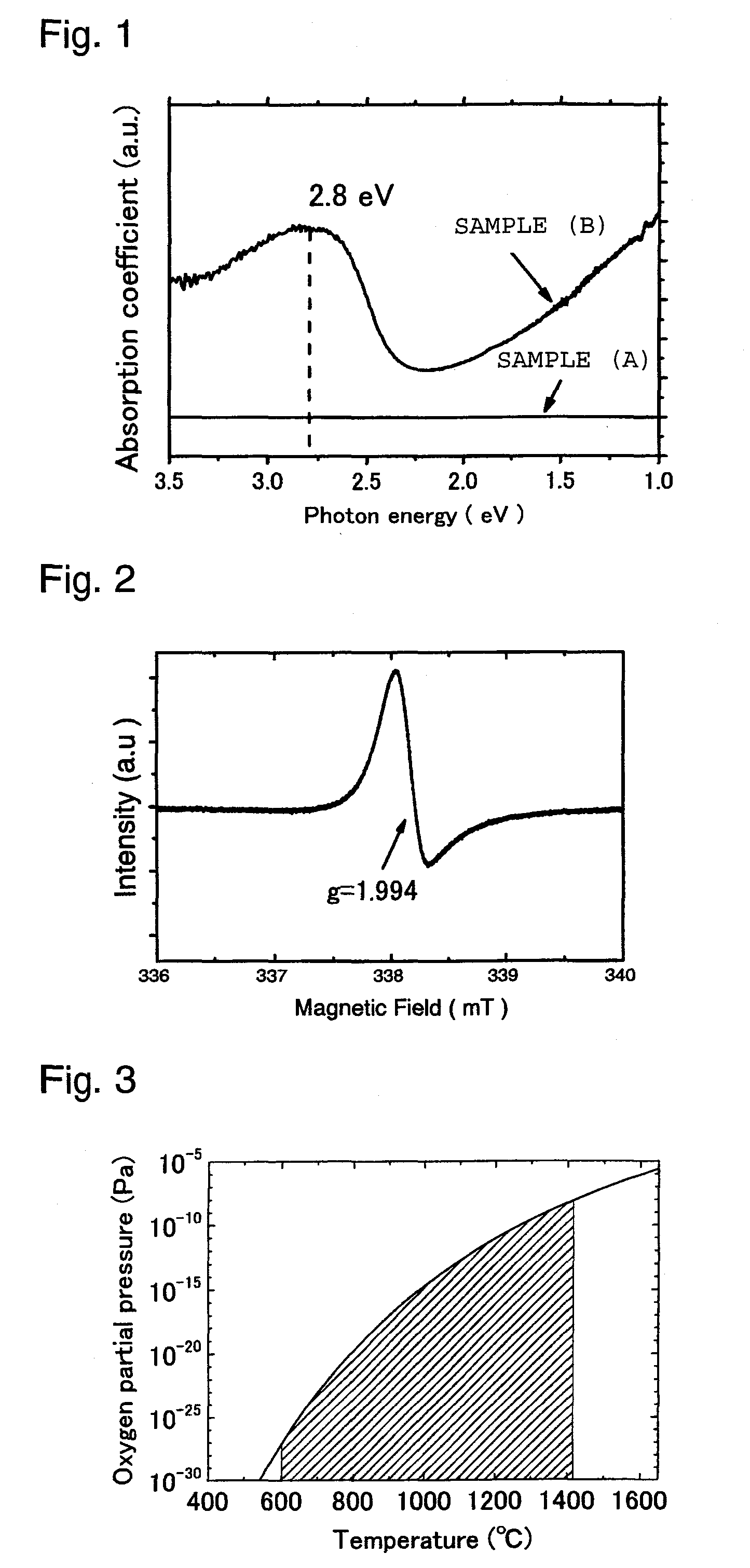Method for preparing electroconductive mayenite type compound
a technology of mayenite and compound, which is applied in the direction of inorganic chemistry, aluminium oxide/hydroxide, crystal growth process, etc., can solve the problems of complex reaction conditions, high cost, and reaction, and achieve low cost, good yield, and good electroconductivity
- Summary
- Abstract
- Description
- Claims
- Application Information
AI Technical Summary
Benefits of technology
Problems solved by technology
Method used
Image
Examples
example 1
[0057] Calcium carbonate and aluminum oxide were blended so that a molar ratio of CaO:Al2O3 became 12:7 as calculated as oxides; the mixture was held at 1,300° C. in atmospheric air for 6 hours, and then cooled to room temperature; the resulting sintered product was pulverized to obtain a powder in a particle size of 50 μm. The resulting powder (hereinafter referred to as “powder A”) was a white insulator and found to be a C12A7 compound with the mayenite type structure by X-ray diffraction.
[0058] The powder A was placed in a covered carbon container and heat treatment was carried out in such a manner that the container was heated to the temperature of 1,300° C. and held for two hours in a nitrogen flow furnace with a nitrogen gas atmosphere having an oxygen concentration of 10 ppm by volume. The atmosphere in the container during the heat treatment had an oxygen partial pressure PO2 of 10−12 Pa by virtue of absorption of oxygen by carbon of the container, which satisfies the relat...
examples 2 to 4
[0060] The crystal powder sample (A) was subjected to heat treatment in an atmosphere maintained at a low oxygen partial pressure by absorption of oxygen by carbon, in the same manner as in Example 1 except that the heat treatment temperature was changed to 1,000° C., 1,100° C. or 1,200° C., thereby obtaining each of heat-treated products of Examples 2 to 4. The oxygen partial pressures PO2 during the heat treatment in Example 2 and in Example 3 were 10−14 Pa and 10−13.5 Pa, respectively, which did not satisfy the relation of Formula (1). In Example 4, it was 10−13 Pa, which satisfied the relation of Formula (1).
[0061] It was confirmed by X-ray diffraction that all the samples thus obtained had the peak of the mayenite type structure. The samples subjected to the heat treatment at 1,000° C. and 1,100° C. were white and insulating with their carrier densities of 1.4×1017 / cm3 and 8.7×1017 / cm3, respectively. The sample subjected to the heat treatment at 1,200° C. showed light green co...
example 5
[0062] The powder A was press-molded to obtain a molded product in depth×width×height of about 2 cm×2 cm×1 cm and the product was placed together with an aluminum metal in a covered alumina container. Heat treatment was carried out in such a manner that the container was heated to the temperature of 1,300° C. and held for 10 hours, in a vacuum furnace vacuumized by a rotary pump. In the container during the heat treatment, the oxygen partial pressure was as low as 10−21 Pa due to absorption of oxygen by aluminum placed together with the molded product in the container, and was the atmosphere under the condition satisfying Formula (1).
[0063] The heat-treated product thus obtained (crystal powder sample (C)) showed brownish black color and it was confirmed by X-ray diffraction measurement that it had the peak inherent to the mayenite type structure. Furthermore, it was found from the photoabsorption spectrum that the electron density was 1.4×1021 / cm3 and the electrical conductivity w...
PUM
| Property | Measurement | Unit |
|---|---|---|
| Temperature | aaaaa | aaaaa |
| Temperature | aaaaa | aaaaa |
| Temperature | aaaaa | aaaaa |
Abstract
Description
Claims
Application Information
 Login to View More
Login to View More - R&D
- Intellectual Property
- Life Sciences
- Materials
- Tech Scout
- Unparalleled Data Quality
- Higher Quality Content
- 60% Fewer Hallucinations
Browse by: Latest US Patents, China's latest patents, Technical Efficacy Thesaurus, Application Domain, Technology Topic, Popular Technical Reports.
© 2025 PatSnap. All rights reserved.Legal|Privacy policy|Modern Slavery Act Transparency Statement|Sitemap|About US| Contact US: help@patsnap.com

